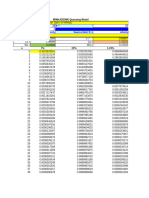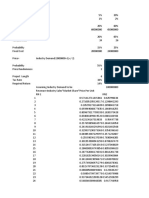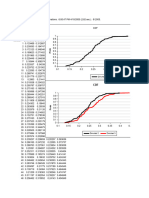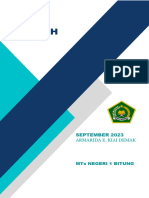0 ratings0% found this document useful (0 votes)
29 viewsFormulas Sistemas de Espera
Formulas Sistemas de Espera
Uploaded by
Lizbeth MuñozThe document summarizes the results of an M/M/c/GD/N/K queueing model with the following parameters: arrival rate (λ) of 15, service rate (μ) of 20, number of servers (c) of 1, unlimited system size (N) and source population (K). The model calculates key metrics like effective arrival rate, utilization, average number of customers in system and queue, and probability of different number of customers in the system.
Copyright:
© All Rights Reserved
Available Formats
Download as XLSX, PDF, TXT or read online from Scribd
Formulas Sistemas de Espera
Formulas Sistemas de Espera
Uploaded by
Lizbeth Muñoz0 ratings0% found this document useful (0 votes)
29 views11 pagesThe document summarizes the results of an M/M/c/GD/N/K queueing model with the following parameters: arrival rate (λ) of 15, service rate (μ) of 20, number of servers (c) of 1, unlimited system size (N) and source population (K). The model calculates key metrics like effective arrival rate, utilization, average number of customers in system and queue, and probability of different number of customers in the system.
Original Title
Formulas-Sistemas-de-Espera.xlsx
Copyright
© © All Rights Reserved
Available Formats
XLSX, PDF, TXT or read online from Scribd
Share this document
Did you find this document useful?
Is this content inappropriate?
The document summarizes the results of an M/M/c/GD/N/K queueing model with the following parameters: arrival rate (λ) of 15, service rate (μ) of 20, number of servers (c) of 1, unlimited system size (N) and source population (K). The model calculates key metrics like effective arrival rate, utilization, average number of customers in system and queue, and probability of different number of customers in the system.
Copyright:
© All Rights Reserved
Available Formats
Download as XLSX, PDF, TXT or read online from Scribd
Download as xlsx, pdf, or txt
0 ratings0% found this document useful (0 votes)
29 views11 pagesFormulas Sistemas de Espera
Formulas Sistemas de Espera
Uploaded by
Lizbeth MuñozThe document summarizes the results of an M/M/c/GD/N/K queueing model with the following parameters: arrival rate (λ) of 15, service rate (μ) of 20, number of servers (c) of 1, unlimited system size (N) and source population (K). The model calculates key metrics like effective arrival rate, utilization, average number of customers in system and queue, and probability of different number of customers in the system.
Copyright:
© All Rights Reserved
Available Formats
Download as XLSX, PDF, TXT or read online from Scribd
Download as xlsx, pdf, or txt
You are on page 1of 11
M/M/c/GD/N/K Queueing Model
Input Data (to enter an infinite value, type i or infinity):
λ = 15 μ= 20
c= 1
Sys. Lim., N= infinity Source limit, K = infinity
Output Results:
eff 15.00000 /c 0.75000
Ls = 2.99999 Lq = 2.24999
Ws = 0.20000 Wq = 0.15000
n Pn CPn 1-CPn
0 0.2500000014 0.2500000014 0.7499999986
1 0.1875000011 0.4375000025 0.5624999975
2 0.1406250008 0.5781250033 0.4218749967
3 0.1054687506 0.6835937539 0.3164062461
4 0.0791015629 0.7626953168 0.2373046832
5 0.0593261722 0.8220214890 0.1779785110
6 0.0444946292 0.8665161182 0.1334838818
7 0.0333709719 0.8998870901 0.1001129099
8 0.0250282289 0.9249153190 0.0750846810
9 0.0187711717 0.9436864906 0.0563135094
10 0.0140783788 0.9577648694 0.0422351306
11 0.0105587841 0.9683236535 0.0316763465
12 0.0079190881 0.9762427415 0.0237572585
13 0.0059393160 0.9821820576 0.0178179424
14 0.0044544870 0.9866365446 0.0133634554
15 0.0033408653 0.9899774099 0.0100225901
16 0.0025056490 0.9924830588 0.0075169412
17 0.0018792367 0.9943622955 0.0056377045
18 0.0014094275 0.9957717231 0.0042282769
19 0.0010570707 0.9968287937 0.0031712063
20 0.0007928030 0.9976215967 0.0023784033
21 0.0005946022 0.9982161990 0.0017838010
22 0.0004459517 0.9986621506 0.0013378494
23 0.0003344638 0.9989966144 0.0010033856
24 0.0002508478 0.9992474622 0.0007525378
25 0.0001881359 0.9994355981 0.0005644019
26 0.0001411019 0.9995767000 0.0004233000
27 0.0001058264 0.9996825264 0.0003174736
28 0.0000793698 0.9997618962 0.0002381038
29 0.0000595274 0.9998214236 0.0001785764
30 0.0000446455 0.9998660691 0.0001339309
31 0.0000334841 0.9998995532 0.0001004468
32 0.0000251131 0.9999246664 0.0000753336
33 0.0000188348 0.9999435012 0.0000564988
34 0.0000141261 0.9999576273 0.0000423727
35 0.0000105946 0.9999682219 0.0000317781
36 0.0000079459 0.9999761678 0.0000238322
37 0.0000059595 0.9999821273 0.0000178727
38 0.0000044696 0.9999865969 0.0000134031
39 0.0000033522 0.9999899491 0.0000100509
40 0.0000025141 0.9999924632 0.0000075368
41 0.0000018856 0.9999943488 0.0000056512
42 0.0000014142 0.9999957631 0.0000042369
43 0.0000010607 0.9999968237 0.0000031763
44 0.0000007955 0.9999976192 0.0000023808
45 0.0000005966 0.9999982158 0.0000017842
46 0.0000004475 0.9999986633 0.0000013367
47 0.0000003356 0.9999989989 0.0000010011
48 0.0000002517 0.9999992506 0.0000007494
49 0.0000001888 0.9999994394 0.0000005606
50 0.0000001416 0.9999995809 0.0000004191
51 0.0000001062 0.9999996871 0.0000003129
52 0.0000000796 0.9999997668 0.0000002332
You might also like
- Manual MyLab 5 PDFDocument80 pagesManual MyLab 5 PDFÉric Scolastici100% (1)
- Pink Card - 2018 - Honda Truck - Van - CR-V Ex-L 4dr AwdDocument2 pagesPink Card - 2018 - Honda Truck - Van - CR-V Ex-L 4dr AwdlediazmNo ratings yet
- Engine Special Tool (S) / General Equipment: 303-01A Engine - 1.5L Ecoboost (118Kw/160Ps) 2013 - 2014 Fusion RemovalDocument41 pagesEngine Special Tool (S) / General Equipment: 303-01A Engine - 1.5L Ecoboost (118Kw/160Ps) 2013 - 2014 Fusion RemovalildefonsoNo ratings yet
- RE-sample MCQ For XQPDocument11 pagesRE-sample MCQ For XQPVenkadeshwaran KuthalingamNo ratings yet
- C SUMITOMO Cyclo PDFDocument148 pagesC SUMITOMO Cyclo PDFMachrus AlfiyanNo ratings yet
- Furuno Fmd3200 Fmd3300 Radar DisplayDocument139 pagesFuruno Fmd3200 Fmd3300 Radar DisplayАлексей СергеевNo ratings yet
- Formulas Sistemas de EsperaDocument11 pagesFormulas Sistemas de Esperabismar jaramillo orellanaNo ratings yet
- Formulas-Sistemas-de-Espera-TAHA (3)Document11 pagesFormulas-Sistemas-de-Espera-TAHA (3)gbenito 35No ratings yet
- Formulas Sistemas de Espera TAHA (1)Document11 pagesFormulas Sistemas de Espera TAHA (1)gbenito 35No ratings yet
- IO222Document22 pagesIO222Armando CastroNo ratings yet
- 2020 Ind 155 Formulas Colas 21Document22 pages2020 Ind 155 Formulas Colas 21Armando CastroNo ratings yet
- 2020 Ind 155 Formulas Colas 21Document11 pages2020 Ind 155 Formulas Colas 21bismar jaramillo orellanaNo ratings yet
- Ind 155 Formulas Colas 21Document11 pagesInd 155 Formulas Colas 21Isidoro VargasNo ratings yet
- Roll Bet Total Amount Lost Probability of Lose Streak (AbDocument6 pagesRoll Bet Total Amount Lost Probability of Lose Streak (AbTanpa NamaNo ratings yet
- UntitledDocument4 pagesUntitledLizanuraidaNo ratings yet
- Re - 10 4Document7 pagesRe - 10 4Antonio Mijail Briceño LiñanNo ratings yet
- Advanced Engineering MathematicsDocument215 pagesAdvanced Engineering MathematicsDivya GroverNo ratings yet
- Cubierta de DoselDocument3 pagesCubierta de DoselRodrigo Chamorro CastroNo ratings yet
- Tabela Correta BetyfureDocument19 pagesTabela Correta BetyfureSAO JOAO D MERITI 8 Ball PollNo ratings yet
- Formula Kindsvater CarterDocument17 pagesFormula Kindsvater CarterJoseHernanRiosRiañoNo ratings yet
- Trabajo de TermobactereologiaDocument9 pagesTrabajo de TermobactereologiaJulio OriaNo ratings yet
- Trigonometric Ratios Chart: Angle Sine Cosine Tangent Angle Sine Cosine TangentDocument1 pageTrigonometric Ratios Chart: Angle Sine Cosine Tangent Angle Sine Cosine Tangentwanianiruddha2005No ratings yet
- UCS CalculationsDocument34 pagesUCS CalculationsArshadNo ratings yet
- Problema Termodinamicay GraficoDocument16 pagesProblema Termodinamicay GraficoDaniel Hernandez AguilarNo ratings yet
- IALM - Mortality Tables (2006-08) UltDocument7 pagesIALM - Mortality Tables (2006-08) UltSimran SachdevaNo ratings yet
- 7752 - Mortality FinalDocument4 pages7752 - Mortality FinalShailendra ShresthaNo ratings yet
- 1611560836127Document48 pages1611560836127Pratik KumarNo ratings yet
- Kare Hava Ve SuDocument27 pagesKare Hava Ve SuBatuhan DÜNDARNo ratings yet
- N (X, Average, Stdev)Document8 pagesN (X, Average, Stdev)AdNo ratings yet
- K1218051 - Novfel Purnama Sari - A - Tugas Statistik 3-1Document4 pagesK1218051 - Novfel Purnama Sari - A - Tugas Statistik 3-1nunikNo ratings yet
- K1218051 - Novfel Purnama Sari - A - Tugas Statistik 3Document3 pagesK1218051 - Novfel Purnama Sari - A - Tugas Statistik 3nunikNo ratings yet
- T P Q P Q P Q: A1 Is Recessive P Q H S A1 Is Additive (No Dominance) P Q H S A1 Is Dominant P Q H SDocument3 pagesT P Q P Q P Q: A1 Is Recessive P Q H S A1 Is Additive (No Dominance) P Q H S A1 Is Dominant P Q H STeflon SlimNo ratings yet
- Black-Scholes Example.Document3 pagesBlack-Scholes Example.Diaa eddin saeedNo ratings yet
- Pieza1.SLDPRT (Project (1) (Predeterminado) )Document5 pagesPieza1.SLDPRT (Project (1) (Predeterminado) )carlvigNo ratings yet
- Hidráulica - Tabela de Perda CargaDocument9 pagesHidráulica - Tabela de Perda CargalucasmajadoNo ratings yet
- CP2- Paper B p1Document15 pagesCP2- Paper B p1jaindevangi97No ratings yet
- UntitledDocument10 pagesUntitledIFKHYNA KHAULA HAKIKANo ratings yet
- CLVDocument17 pagesCLVAbhijeet GangulyNo ratings yet
- Aula 2 Mrp250Document123 pagesAula 2 Mrp250Matheus MacedoNo ratings yet
- Laboratory Activity 8,9,10,11 - 091346Document22 pagesLaboratory Activity 8,9,10,11 - 091346Vanvan BitonNo ratings yet
- GeankDocument17 pagesGeankAdy DLCNo ratings yet
- Latihan UTS 2016Document210 pagesLatihan UTS 2016Kevin AndikaNo ratings yet
- Material PropertiesDocument6 pagesMaterial PropertiesSAKSHAR BANERJEENo ratings yet
- Perfil Naca de 4 Digitos: y (M/P) - (2px-x), para 0 X P y (M/ (1-p) ) - (1-2p+2px-x), para P X 1Document19 pagesPerfil Naca de 4 Digitos: y (M/P) - (2px-x), para 0 X P y (M/ (1-p) ) - (1-2p+2px-x), para P X 1412460No ratings yet
- Practica 1formularioDocument65 pagesPractica 1formularioneosalison014No ratings yet
- HTML CodeDocument2 pagesHTML CodekrosiarbjasNo ratings yet
- HTML CodeDocument2 pagesHTML CodekrosiarbjasNo ratings yet
- Volumen de arbolesDocument2 pagesVolumen de arbolesJosé Fernando Ramiro ContrerasNo ratings yet
- Chart Title: P (1) (Revolution:O) (Rad) Moment (Z) (Revolution:O) (N.M)Document20 pagesChart Title: P (1) (Revolution:O) (Rad) Moment (Z) (Revolution:O) (N.M)AndresEstebanSilvaSanchezNo ratings yet
- Identifikasi Pemodelan Matematis Robot Wall FollowingDocument9 pagesIdentifikasi Pemodelan Matematis Robot Wall FollowingFahmi JidanNo ratings yet
- Probability DistributionsDocument12 pagesProbability DistributionsSalvatoreNo ratings yet
- Unidad 3Document48 pagesUnidad 3Luis Diego Peralta PerezNo ratings yet
- Tabla de áreas de la curva normal A B CDocument9 pagesTabla de áreas de la curva normal A B Cdanaesperanza387No ratings yet
- Metodo de Jacobi X yDocument19 pagesMetodo de Jacobi X ydangcasNo ratings yet
- Tugas Biomet IndividuDocument14 pagesTugas Biomet IndividuMufris SaNo ratings yet
- Ex 3 Salman PDFDocument7 pagesEx 3 Salman PDFMazhar AbbasNo ratings yet
- Chart TitleDocument8 pagesChart TitlejuniorNo ratings yet
- Trial Filter Sinyal - Nurul HidayatiDocument6 pagesTrial Filter Sinyal - Nurul HidayatiibluungNo ratings yet
- Lissajous FigureDocument57 pagesLissajous Figurespacetrash854No ratings yet
- HW01 Proy 003Document18 pagesHW01 Proy 003Juan Diego Medina MedinaNo ratings yet
- Detyra e Fundit OptimizimDocument4 pagesDetyra e Fundit OptimizimRiçard HoxhaNo ratings yet
- Contoh IVP Sistem PDBDocument6 pagesContoh IVP Sistem PDBMuhammad RizaldiNo ratings yet
- Book 1Document1 pageBook 1Kesarapu Venkata ApparaoNo ratings yet
- JooooDocument3 pagesJooooJosé LuisNo ratings yet
- NRTL MethodDocument18 pagesNRTL MethodNurfarahin AzmanNo ratings yet
- United States Census Figures Back to 1630From EverandUnited States Census Figures Back to 1630No ratings yet
- Curva RC 50-16 2900 (T-1092)Document1 pageCurva RC 50-16 2900 (T-1092)Milan GrujićNo ratings yet
- SOP For Unloading, Storage, Handling and Use of Compressed Gas CylindersDocument3 pagesSOP For Unloading, Storage, Handling and Use of Compressed Gas CylindersSolomonNo ratings yet
- Proceedings of I4SDG Workshop 2021: Giuseppe Quaglia Alessandro Gasparetto Victor Petuya Giuseppe Carbone EditorsDocument657 pagesProceedings of I4SDG Workshop 2021: Giuseppe Quaglia Alessandro Gasparetto Victor Petuya Giuseppe Carbone Editorsadam.wtadNo ratings yet
- Ion EZVC-QuickstartGuide-v2.1Document11 pagesIon EZVC-QuickstartGuide-v2.1kosarobNo ratings yet
- MAR201 Consumer Behavior - UEH-ISB - Unit Guide - Thu NguyenDocument15 pagesMAR201 Consumer Behavior - UEH-ISB - Unit Guide - Thu NguyenMyNo ratings yet
- LABORATORY EXERCISE 4 Prince Joseph SalesDocument4 pagesLABORATORY EXERCISE 4 Prince Joseph SalesRheny BondocNo ratings yet
- HKCERT CTF 2024_ Guide to Beginner-friendly Challenges (I) - HackMDDocument43 pagesHKCERT CTF 2024_ Guide to Beginner-friendly Challenges (I) - HackMDtuanduy25082005No ratings yet
- HostsDocument7,045 pagesHostsMalikNo ratings yet
- 1.2-DE Unit 1 - Arithmatics in Number SystemDocument76 pages1.2-DE Unit 1 - Arithmatics in Number Systemnaman shahNo ratings yet
- B Tech CSE Sem5 SyllabusDocument19 pagesB Tech CSE Sem5 SyllabusJayant PahwaNo ratings yet
- Cover LKHDocument4 pagesCover LKHArmarida Exliyustika Kiai DemakNo ratings yet
- Data Transmission Through LifiDocument6 pagesData Transmission Through Lifidhruv khatriNo ratings yet
- Top Nocht Unit 4Document2 pagesTop Nocht Unit 4InteresingNo ratings yet
- Vertical Indicator Post LF IP555 - LIFECODocument1 pageVertical Indicator Post LF IP555 - LIFECOgoviaNo ratings yet
- 13 Camco Gas Lift Product Catalog 1987Document93 pages13 Camco Gas Lift Product Catalog 1987Cluis KeNo ratings yet
- Trakheesi User Guide EngDocument49 pagesTrakheesi User Guide EngAnwar salaudheenNo ratings yet
- Cryptography and Network Security: Sixth Edition by William StallingsDocument35 pagesCryptography and Network Security: Sixth Edition by William StallingsSachin PathakNo ratings yet
- ULIP SARATHI Integration RequirementDocument8 pagesULIP SARATHI Integration RequirementGokulganth ThirumalNo ratings yet
- How2Pass CCNA 200-301 Online Practice Tests: Print This PageDocument35 pagesHow2Pass CCNA 200-301 Online Practice Tests: Print This PageAlex GonçalvesNo ratings yet
- PDF AnDocument44 pagesPDF AnAriel Luiz Andreola CHANCELLLERNo ratings yet
- Third Revolution HistoryDocument13 pagesThird Revolution HistoryAndrés RomeroNo ratings yet
- CS301 Short Notes For Midterm Exams 2021 DownloadDocument6 pagesCS301 Short Notes For Midterm Exams 2021 DownloadIsha NasNo ratings yet
- Pots and Trade: Spacefillers or Objets D'Art?: Article by David W. J. GillDocument11 pagesPots and Trade: Spacefillers or Objets D'Art?: Article by David W. J. GillThomas SwantonNo ratings yet
- 4.1.3.4 Packet Tracer - Configuring IPv6 ACLsDocument4 pages4.1.3.4 Packet Tracer - Configuring IPv6 ACLsABDERABBI RHAZLAHJORNo ratings yet

























































































